The Polynesian Cultural Center honored Tausilinu’u David Hannemann, 92, a Samoan with German heritage, as its first full-time paid employee and most-senior living associate when he retired — again — during a special “graduation” ceremony on December 28, 2017. Four generations of his family, friends and PCC colleagues marked the occasion with Polynesian chanting, gift-giving, memories, praises and, of course, a feast.
‘Uncle David,’ the perfect Polynesian host
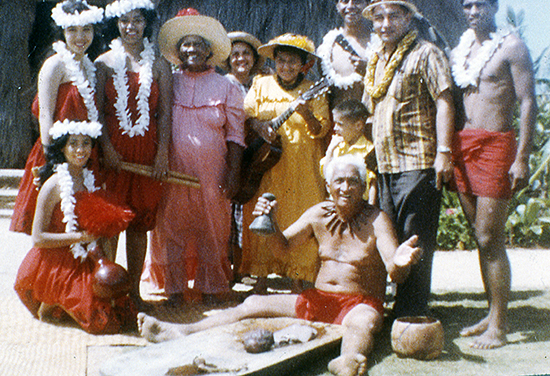
David Hannemann (2nd from rt) with Hawaiian Villagers at the PCC in the 1960s
The First Presidency of The Church of Jesus Christ of Latter-day Saints approved hiring Hannemann — who everybody now calls “Uncle David,” in the island way — while labor missionaries and community volunteers were still finishing the visitor attraction. In fact, the eventual name for the center hadn’t even been selected yet, but it had become apparent program and personnel plans had to be put in place before the grand opening on October 12, 1963.
Uncle David was the right man for the job. He had left his native Samoa in the late 1940s, and spent some time in Hawaii and Utah. From 1949-51 he served as a Mormon missionary in Hawaii, starting at the Hansen’s Disease colony at Kalaupapa, Molokai, where he learned to speak Hawaiian. Following his mission, he settled in Los Angeles, married Carolyn Harline, and began to raise a family that eventually totaled nine boys and two girls. He also started a family Polynesian luau catering business.
After the Center officially opened, Uncle David served as operations manager, implementing PCC programs and activities that are still popular almost 55 years and 40 million visitors later, including guide services, the popular canoe tour, canoe pageant and luau dinner.
The longest-living ‘treasure’
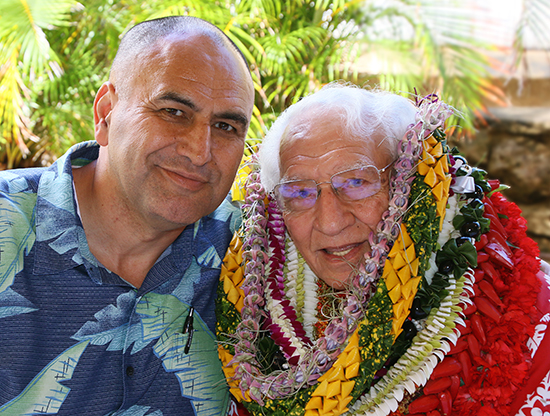
Uncle David with PCC President P. Alfred Grace
“David is the first and the longest-living ‘treasure’ we have here at the Polynesian Cultural Center,” said Alfred Grace, PCC president and chief executive officer. “We refer to our ‘graduates’ as ‘living treasures,’ because they are foundational to the Center, and their mana [spiritual essence] will remain here forever. This includes our labor missionaries [several of whom were at the event], who built the Polynesian Cultural Center.”
“We’re so grateful to have this opportunity to acknowledge not only Tausilinu’u David Hannemann, but also his eternal companion, Carolyn,” Grace said. “I am so grateful to David Hannemann for all that he has done. We love them both dearly here at the Polynesian Cultural Center.”
“We love you, David, with all our hearts. Your legacy will always live on here at the Polynesian Cultural Center. You will always be a part of our ‘family,’ and you will always have a place in the PCC whenever you need it. We wish you the very best.”
PCC re-drafts Uncle David in 1983
Having set the Center on a course to eventual success in those early years, Hannemann returned to California in 1969 to rekindle his luau business and also work in tourism management; but then-PCC president William H. “Bill” Cravens recruited him to return as a senior vice president in 1983.
For the next 22 years, Hannemann applied his creativity and distinctive management style to many Polynesian Cultural Center departments. For example, he started the successful Laie tour, which has spurred several million people to include the Laie Hawaii Temple Visitors Center in their PCC experience. He also helped completely overhaul the Center’s food and beverage operations, and turned the PCC’s original Hale Aloha theater into the primary venue for the award-winning Alii Luau.
He also shared his aloha spirit with countless guests, and mentored new generations of young PCC employees.
Uncle David retires for the first time
Uncle David retired from the Center for the first time in 1995, when he and Carolyn were called to serve as full-time president and matron of the Laie Hawaii Temple for the next three years. After completing that service, Hannemann volunteered for almost 20 years to help compile the history of the Polynesian Cultural Center.
PCC ‘ohana honors Uncle David’s service
During the “graduation” event, some of these recalled Uncle David’s contributions, wit and practical jokes over the years. A number drew laughter as they told how he could turn driving his electric utility vehicle through the PCC villages into a thrill ride.
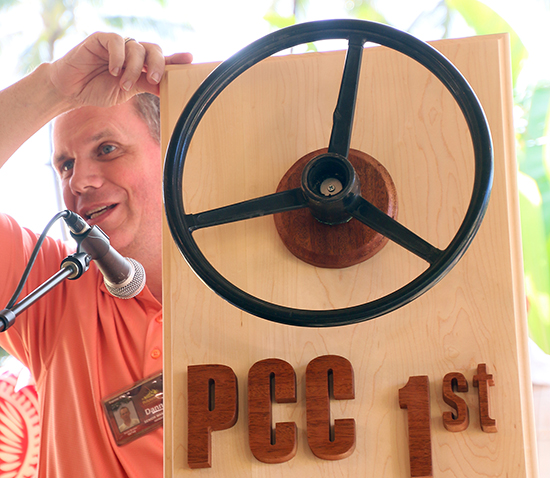
Dan Briskin recognizes Uncle Davids ‘cart driving skills’
Several related how former PCC president Lester W.B. Moore recognized Uncle David’s great faith, putting him “in charge of the weather. Every single, important function where we have needed to have good weather, we put Uncle David in charge, and we had exactly the kind of weather we needed,” said Delsa Atoa Moe, vice president of cultural presentations. She also praised him as an “immaculate dresser” who often wore white pants and shoes, and a large mother-of-pearl shell pendant.
She and others also recounted his unique training methods, which could include climbing step-ladders and standing on tables to emphasize points. He also often used posters that Carolyn, who had graduated in art education from Pepperdine University, hand-lettered for him. As he has for many years, he typically saved all these materials.
Deep respect for Uncle David’s Polynesian heritage
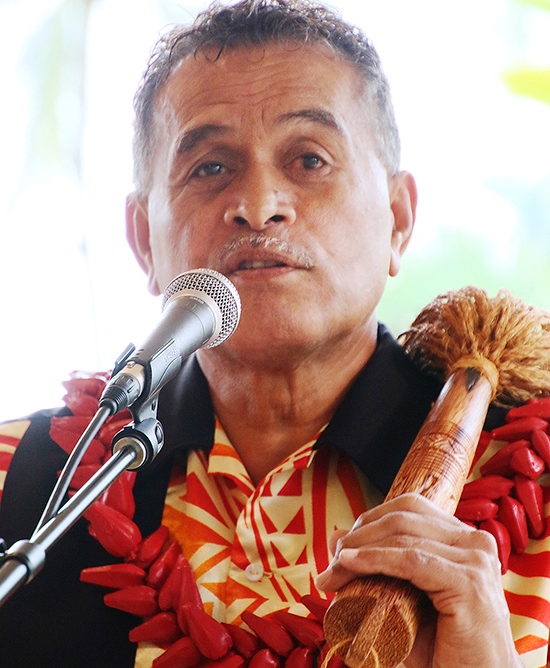
Tipa Galeai
Accolades from PCC village representatives also showed their deep respect for Uncle David’s Polynesian roots. For example:
Speaking in Samoan, Islands director Steve Laulu said “there are no words to express thanks equivalent to your efforts at the PCC. We will not only remember them, but we will also try to work hard to make the PCC even better and more beautiful for those who come here.”
Later, Samoan Village manager Tipa Galea’i presented Uncle David with a to’oto’o [orator’s staff], fue [scepter-like whisk] and red pandanus-seed ulafala –lei — all implements of chiefly Samoan leadership.
Galea’i also compared Uncle David to a poutu, a tree trunk “pillar that holds up a building. That’s who you are to us, Uncle David,” he said.
A Hawaiian paddle…
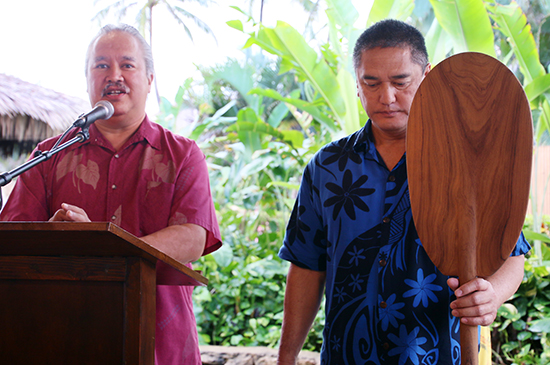
Naauao Pane’e and Kaipo Manoa
Each of the Polynesian Cultural Center villages and departments made presentations. For example:
On behalf of the Hawaiian village, assistant manager Naauao Pane’e first addressed Uncle David in Hawaiian, and then he and manager Kaipo Manoa presented him with a carved hoe koa — a solid koa-wood paddle. Pane’e explained it was a traditional symbol for working hard, “because it is the hoe that makes a canoe go, and it is the hoe uli of a voyaging canoe that steers it to its destination. He also pointed out that Manoa was rubbing down the hoe with kukui [candlenut] oil, another symbol of light and leadership.
“This is a small gift, but a great one in all our hearts and love for you on this special day,” Pane’e added.
A Tongan ‘pillow’…
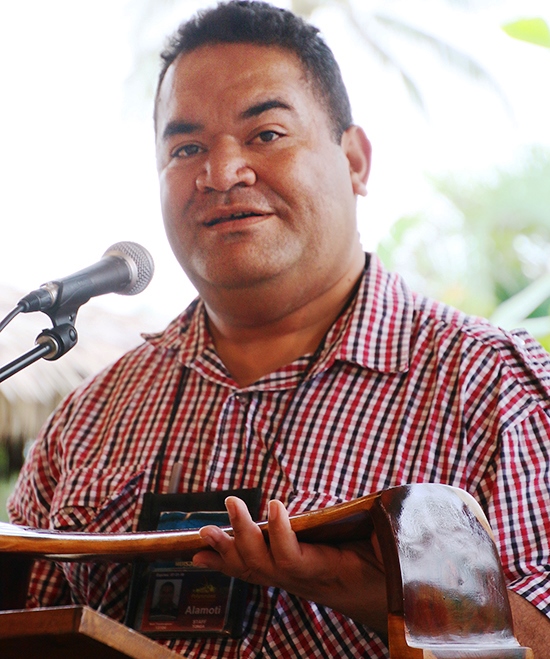
‘Mot’i Taumoepeau
Tongan Village manager Alamoti Taumoepeau presented Carolyn with a large piece of tapa or bark cloth made at the PCC, and Uncle David with a hand-carved wooden kali, a traditional neck-rest “pillow.”
“In Tongan culture this is symbolic of the kali loa — the long arm of a parent,” Taumoepeau explained. “There’s a Tongan expression that whenever anyone succeeds, graduates, or excels in any event or activity, we always say [translated], it is no surprise or wonder, because he or she rested on the kali loa or the arm of the parent.”
“This is symbolic of Tonga’s greatest learning institution, because all learning happens in the arms of the parents,” Taumoepeau continued. “Today, I not only pay tribute to you and the wonderful legacy you have left us, but also to thank your parents and your forefathers for giving us one of PCC’s greatest sons, and for his loving us with the many experiences and stories we will always treasure.”
A Maori adze…
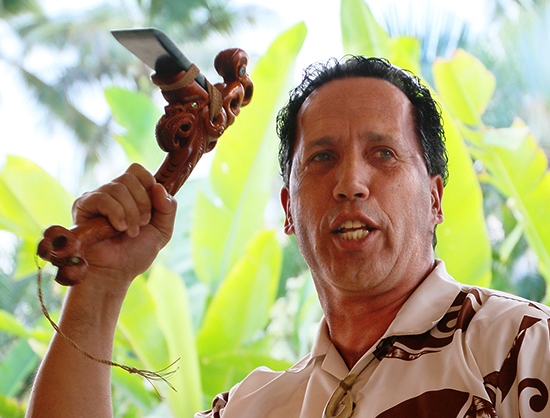
Kim Makekau
And Aotearoa Islands manager Kim Makekau presented Uncle David with a beautifully carved toki poutangata — a ceremonial adze with a semi-precious greenstone blade lashed to a highly carved handle. “This adze establishes a man of great mana or authority and those leadership qualities we all know and have heard expressed today.” He also traced the genealogy of the carvers leading to Doug Christy and this adze, and explained:
The carved figure at the top of the handle represents Tausilinu’u, DH’s first name. That figure is upheld by Tanenuiarangi, “the son of the sky father.” The highly prized greenstone symbolizes Carolyn Hannemann; along the handle, “the symbols of their posterity that will go with them into eternity; and the final figure at the base represents the hokioi,” a symbol of the Spirit that guides us all.”
Makekau suggested it is comparable to a royal scepter “as a symbol of rank and power.”
He and Seamus Fitzgerald, PCC’s Director of Culture, finished with a rousing Maori haka.
‘It doesn’t seem like enough’
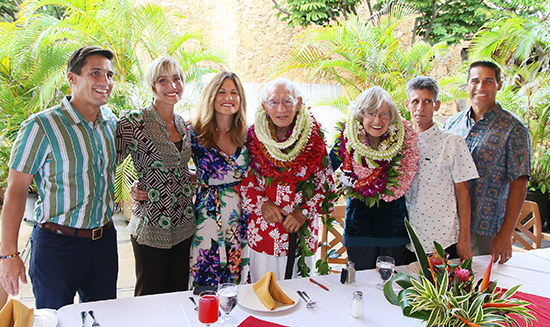
David and Carolyn Hannemann with some of their family
“After all the gifts and wonderful thoughts, it doesn’t seem like enough to honor Uncle David,” said Eric Workman, PCC chief marketing officer and vice president, who emceed the event. “Our purpose for meeting today was not only to remind him that we remember all that he has contributed to the Center, but we wanted Carolyn to know how much we have appreciated your family and your service through David.”
“We wanted the children and grandchildren to know that we remember. We wanted you to have a glimpse of what your father has done, and all that we are indebted to him for, including the literally millions of people that his work has touched. Our Heavenly Father is well aware of his sacrifices and work.”
‘Sought wisdom on his knees’
Following the presentations, Hannemann’s son, Howard, said of his father on behalf of the family, “The secret of his success is that he sought wisdom on his knees. I can’t tell you how many early mornings we’d get up, and we’d see him on his knees. All of us, as we’ve grown up, have said we want to be like dad.”
And in conclusion, David Hannemann responded, “Laie is a great place to grow old. My heart is overflowing with gratitude for each and every one of you. I love you. I will try to be worthy of all the love and kind things you’ve said about me.”
“I promise you that each and every one of you here has been blessed,” he said. He also predicted that some of his grandchildren would be at the centennial celebration for the Polynesian Cultural Center in 2066.
 Story and contemporary photos by Mike Foley, who has been a full-time freelance writer and digital media specialist since 2002. Prior to that he had a long career in marketing communications, PR, journalism and university education. Foley learned to speak fluent Samoan as a Mormon missionary before moving to Laie in 1967 — and still does. He has traveled extensively over the years throughout Polynesia, other Pacific islands and Asia. Foley is mostly retired now, but continues to contribute to PCC and various other media.
Story and contemporary photos by Mike Foley, who has been a full-time freelance writer and digital media specialist since 2002. Prior to that he had a long career in marketing communications, PR, journalism and university education. Foley learned to speak fluent Samoan as a Mormon missionary before moving to Laie in 1967 — and still does. He has traveled extensively over the years throughout Polynesia, other Pacific islands and Asia. Foley is mostly retired now, but continues to contribute to PCC and various other media.
Foley first met David Hannemann in 1967

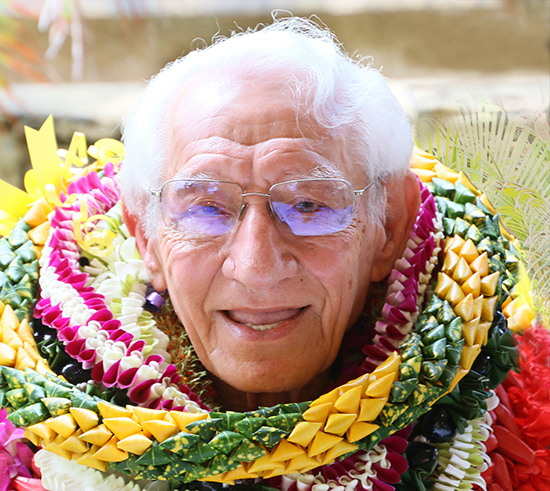
I enjoyed this article very much! David is a long time family friend and it was so heartwarming to hear that he was honored in such a special way!
Wonderful article for a wonderful man. My wife and I worked with David at Movieland Wax Museum. He was one of our matchmakers. We are still happily married 42 years later. He was a great boss and friend. On our two trips to Hawaii he and his wife welcomed us into their home.
Thank you honoring this great man.
Jay and Frances Cardillo
Clovis, CA